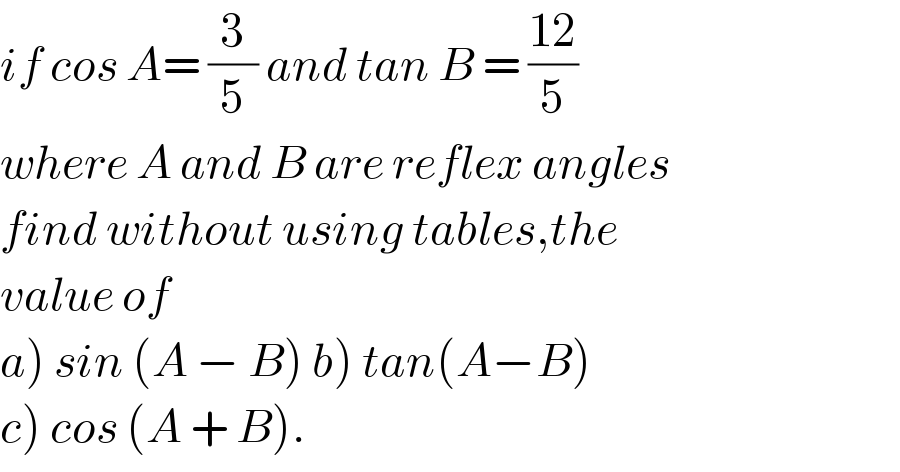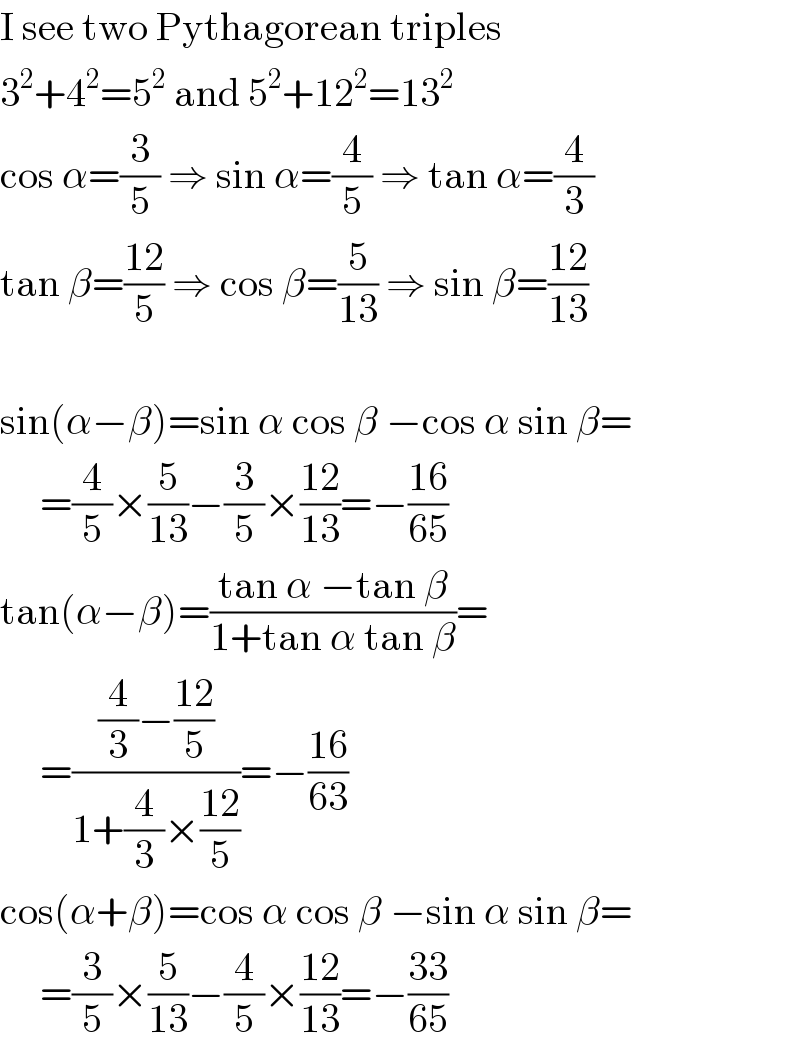Question Number 39588 by Rio Mike last updated on 08/Jul/18

$${if}\:{cos}\:{A}=\:\frac{\mathrm{3}}{\mathrm{5}}\:{and}\:{tan}\:{B}\:=\:\frac{\mathrm{12}}{\mathrm{5}} \\ $$$${where}\:{A}\:{and}\:{B}\:{are}\:{reflex}\:{angles} \\ $$$${find}\:{without}\:{using}\:{tables},{the} \\ $$$${value}\:{of} \\ $$$$\left.{a}\left.\right)\:{sin}\:\left({A}\:−\:{B}\right)\:{b}\right)\:{tan}\left({A}−{B}\right) \\ $$$$\left.{c}\right)\:{cos}\:\left({A}\:+\:{B}\right). \\ $$
Answered by MJS last updated on 08/Jul/18

$$\mathrm{I}\:\mathrm{see}\:\mathrm{two}\:\mathrm{Pythagorean}\:\mathrm{triples} \\ $$$$\mathrm{3}^{\mathrm{2}} +\mathrm{4}^{\mathrm{2}} =\mathrm{5}^{\mathrm{2}} \:\mathrm{and}\:\mathrm{5}^{\mathrm{2}} +\mathrm{12}^{\mathrm{2}} =\mathrm{13}^{\mathrm{2}} \\ $$$$\mathrm{cos}\:\alpha=\frac{\mathrm{3}}{\mathrm{5}}\:\Rightarrow\:\mathrm{sin}\:\alpha=\frac{\mathrm{4}}{\mathrm{5}}\:\Rightarrow\:\mathrm{tan}\:\alpha=\frac{\mathrm{4}}{\mathrm{3}} \\ $$$$\mathrm{tan}\:\beta=\frac{\mathrm{12}}{\mathrm{5}}\:\Rightarrow\:\mathrm{cos}\:\beta=\frac{\mathrm{5}}{\mathrm{13}}\:\Rightarrow\:\mathrm{sin}\:\beta=\frac{\mathrm{12}}{\mathrm{13}} \\ $$$$ \\ $$$$\mathrm{sin}\left(\alpha−\beta\right)=\mathrm{sin}\:\alpha\:\mathrm{cos}\:\beta\:−\mathrm{cos}\:\alpha\:\mathrm{sin}\:\beta= \\ $$$$\:\:\:\:\:=\frac{\mathrm{4}}{\mathrm{5}}×\frac{\mathrm{5}}{\mathrm{13}}−\frac{\mathrm{3}}{\mathrm{5}}×\frac{\mathrm{12}}{\mathrm{13}}=−\frac{\mathrm{16}}{\mathrm{65}} \\ $$$$\mathrm{tan}\left(\alpha−\beta\right)=\frac{\mathrm{tan}\:\alpha\:−\mathrm{tan}\:\beta}{\mathrm{1}+\mathrm{tan}\:\alpha\:\mathrm{tan}\:\beta}= \\ $$$$\:\:\:\:\:=\frac{\frac{\mathrm{4}}{\mathrm{3}}−\frac{\mathrm{12}}{\mathrm{5}}}{\mathrm{1}+\frac{\mathrm{4}}{\mathrm{3}}×\frac{\mathrm{12}}{\mathrm{5}}}=−\frac{\mathrm{16}}{\mathrm{63}} \\ $$$$\mathrm{cos}\left(\alpha+\beta\right)=\mathrm{cos}\:\alpha\:\mathrm{cos}\:\beta\:−\mathrm{sin}\:\alpha\:\mathrm{sin}\:\beta= \\ $$$$\:\:\:\:\:=\frac{\mathrm{3}}{\mathrm{5}}×\frac{\mathrm{5}}{\mathrm{13}}−\frac{\mathrm{4}}{\mathrm{5}}×\frac{\mathrm{12}}{\mathrm{13}}=−\frac{\mathrm{33}}{\mathrm{65}} \\ $$
